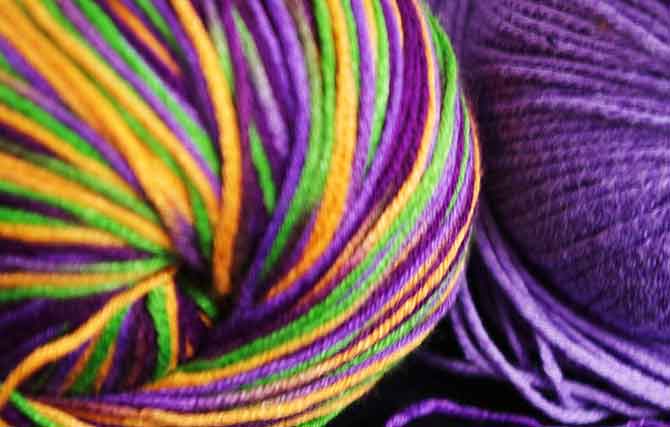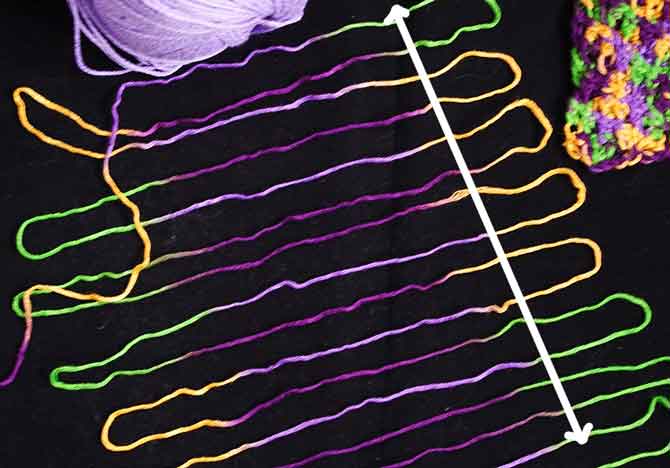Bamboo Pop Yarn comes in 18 variegated colorways.
Many people fall in love with multi-colored or variegated yarns when they see the skeins or balls on the shelves or in the store bins, or in the online catalogues. All the color matching and coordinating has been done for you and you don’t have to think about which color would go with which. Not everyone is comfortable choosing various colors to knit together in the same project, so variegated yarn is the answer.
For some however, once they knit the variegated yarn, they’re frustrated with how it looks, particularly when one of the color seems to collect all in one area of the fabric, and sometimes not in flattering ways. This is called “the pooling effect” and it’s not everyone’s favorite. There are a few ways to avoid pooling and we’ll look at three of them.

Bamboo Bop Variegated Yarn
Method One
Use 2 different balls of the same yarn. This is a quite common solution. You knit 2 rows with one ball of yarn. Then you attach another ball of yarn and make sure that you’re at a different spot in the color sequence and you knit 2 rows with that ball of yarn. Then you simply alter the ball of yarn feeding your knitting every two rows. This is the same strategy knitters use when they mistakenly have a ball of yarn that’s a different dye-lot than the rest, or when sadly, they’ve had to buy that one extra ball just to finish a sleeve or neckline.

Method 2: alternating rows with solid and variegated yarns
Method Two
I tried alternating 2 rows of variegated Bamboo Pop with 2 rows of a solid color as in the photo above. The variegated colorway is Grape Garden, and the solid is called Grape. Also, I tried a textured stitch pattern that isn’t just garter stitch or stockinette stitch. This breaks up the colors very well.

Close up: alternating rows of solid and variegated Bamboo Pop
Above is a close-up of this stitch pattern which as you can see does a nice job at distributing the colors so they look like small bursts of color that pop. To knit this stitch pattern, following these instructions.
Stamen Stitch
With solid yarn, cast on an odd number of stitches. Include 2 sts extra, one for each side as selvedge stitches.
Rows 1(RS): With multicolored yarn, sl first st knitwise, knit across.
Row 2: Sl first st knitwise, k1, *with yarn at back, sl 1 purlwise, k1; rep from * to last st, k1.
Row 3: With solid yarn, sl first st knitwise, knit across.
Row 4: Sl first st knitwise, with yarn at back, sl 1 purlwise, *k1, sl 1 purlwise; rep from * to last st, k1.

Using the dye pattern in Bamboo Pop

Find the dye pattern in the yarn and determine how many stitches are used to knit each color segment
Method Three
Another way to avoid pooling colors with variegated yarn is to find the dye pattern in the yarn and determine how many stitches are used to knit each color segment.
In the above photo, where I laid the yarn out, you can see that the pattern is dark purple, yellow, light purple, yellow, dark purple green, light purple, yellow, and so on. Each color segment is roughly the same length. When I knit the yarn to the gauge that I wanted, each color segment took 8 stitches to work, and sometimes 7. I tried to see if the use of 7 stitches was a regular feature of the color pattern, but it wasn’t, so that little bit of randomness happened during the dyeing process.
So I cast on a multiple of 8 stitches. What resulted was this slight zigzag pattern with the 2 purples running diagonally alternating with the green and yellow forming the other part. I think that if I had worked a multiple of 16 sts plus 4, I may have been able to achieve columns of purples stacked on top of each other, and columns of green and yellow stripes. There’s no way to be sure but to swatch a lot.
As you can see in the picture below, about 2 meters of yarn was needed to reach the full color repeat, which I indicate with the white line.

Full length of color pattern repeat
Because I didn’t cast on the number of stitches that it would have taken to use one full color repeat (which would have been 240 sts), I’m pretty much guaranteed that I won’t get true columns of stitches, but I think by using multiples of 8 in this case, I could have worked out some sort of pattern that would have avoided pooling quite well.
If I were going to knit a sweater with 69 sts on the back and 69 sts on the front, I would run a greater risk of developing pooling because the 8 st segment wouldn’t work across 69 sts. So other strategies would be needed to fine tune. I could work intarsia and have 2 balls of yarn twisting part way across the row. I could knit smaller pieces and seam them together to form the front or back of the sweater. There are many ways to experiment and to get the effect you want and to be happy with your multi-colored yarn. A fourth method is to crochet with it, as in the picture above! Now I’m just being cheeky, but it does give a different look that distributes the colors well and avoids pooling completely.

A fourth method is to crochet with variegated yarn, it does give a different look that distributes the colors well and avoids pooling completely
This is part 3 of 5 in this series.
Go back to part 2: 3 ways washing your knitting affects your gauge
Go to part 4: 3 projects I would knit with Bamboo Pop yarn

2 comments
can i do a double knit pattern with two skeins of variegated yarn? is it done? or is double knitting always done with two different solid colors of yarn?
Hello Carolyn,
It IS possible to work a double-knit pattern with two skeins of variegated yarn; however, there are a few suggestions I have for you. Use a dark-toned variegated yarn that doesn’t have any light patches as one yarn and a variegated yarn that is light-toned without dark patches. You can also use two colorways that make each other vibrate…like you could use a green-ombre-variegated yarn as one color and a red-orange-purple variegated yarn as the contrast. The other thing to take into account would be the complexity of the pattern. If there are lots of 1-stitch changes, two variegated yarns would just be a speckled mess and you wouldn’t see the pattern, but if there are larger blocks of 5 or 6 stitches, then it would work fine. Using a solid as one yarn and a variegate or ombre yarn as the 2nd yarn would really look great, as long as the solid yarn was a color NOT featured in the coordinating variegate. To see some multi-colored double knits, check out Sockmatician on Instagram and Youtube. He does a lot of “risk-taking” with colors and double-knitting.